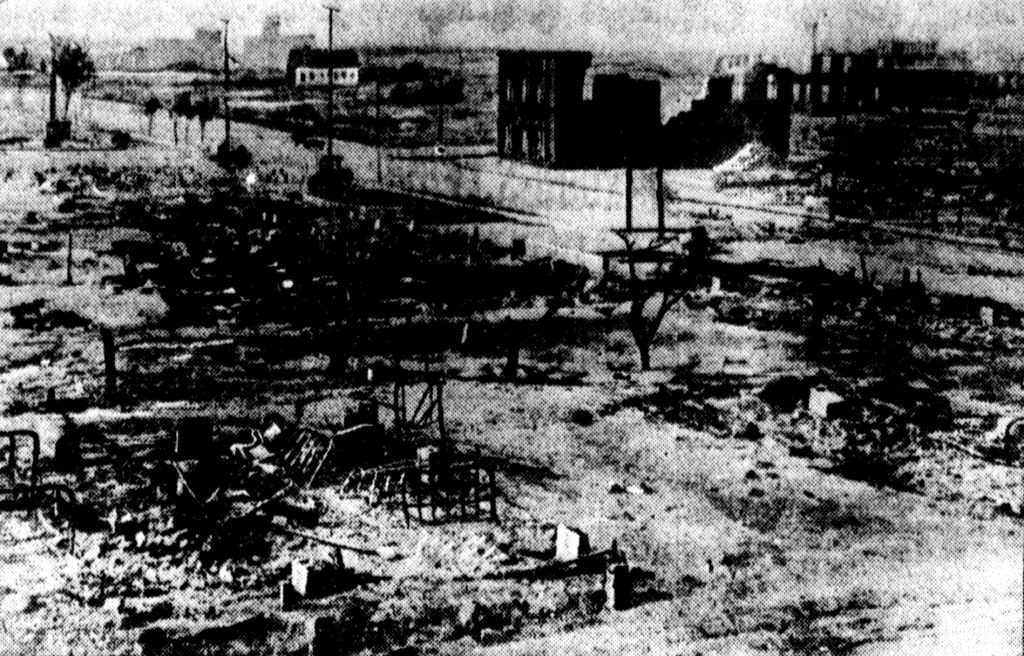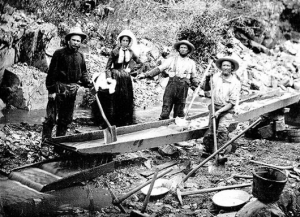Today Americans still debate what occurred between Dick Rowland and Sarah Page in the Drexel building elevator on downtown of Tulsa’s Main Street on May 30, 1921. Dr. Scott A. Ellsworth, a University of Michigan professor who teaches courses on African American history, Southern literature, and crime and justice in contemporary U.S. society, concludes that Rowland, to save himself from falling after tripping in an elevator on his way to the ‘colored’ bathroom, grabbed onto the first thing in his line of sight. That thing he caught happened to be the arm of a white elevator operator, Sarah Page.1
This encounter alarmed Page, causing her to scream. After hearing Page’s cry and seeing Rowland flee from the elevator, an unknown white store clerk called the police to report an attempted assault. The following day, May 31, police arrested 19-year-old Rowland based on accusations from both Ms. Page and the clerk. In none of the accounts studied today is there evidence that Rowland attempted to assault Page.2 Although we agree on this fact today, Tulsans at the time believed the rumors published by local newspapers that Rowland had attacked, and even attempted to rape Page, “scratching her hands and ripping her clothes.”3 This incident became the catalyst for one of the worst race riots in American history. And shockingly, this story does not usually appear in history textbooks.
Dick Rowland, born Jimmie Jones, lived with his two orphaned sisters in Vinita, Oklahoma during his childhood. Their birthplace is unknown. An African American woman by the name of Damie Ford informally adopted Jones by the time he was six years old. By 1909, Jones and Ford had moved to Tulsa to join Ford’s family, the Rowlands, where he then adopted their surname and chose his own first name, Dick.4

Greenwood in Tulsa, Oklahoma, established as a town in the early 1900s, still abided by the laws of Jim Crow and segregation even though it had a lot of independent African American economic activity.5 Rowland began his schooling in Tulsa, then later dropped out of Booker T. Washington High School at the age of 19 to work at a white-owned parlor as a shoe shiner. This behavior was not unusual seeing as a shoe shiner in Tulsa, whether African American or white, could get a tip anywhere from $1-$5, which was decent money in the early twentieth century. Greenwood district in Tulsa, with over 6,000 residents, black-owned businesses, schools, hospitals, newspapers, staffed with African American professionals, was one of the most prosperous African American communities in the country at the time.6

At approximately 3:15 PM on the day of Rowland’s trial, the Tulsa Tribune published and released the article “Nab Negro for Attacking Girl in Elevator” to the general public. At this time, the Tulsa Tribune was a Republican paper, edited and published since 1919 by the controversial racist Richard Lloyd Jones. This inflammatory article gave Rowland the pejorative nickname “Diamond Dick” and strongly implied that Rowland had raped Sarah Page. This issue also published an editorial warning titled “To Lynch a Negro Tonight,” which started the rumor that Rowland would be lynched that night. This rumor, in addition to others stirred up by the publishings of the Tulsa Tribune, fueled high emotion in the surrounding community.7 This build-up of concern, confusion, and anger ravaged the community and led to the gathering of armed white World War I veterans to rally for Rowland being put in jail, alongside African American locals anxious that the boy would be killed over a misunderstanding. The two groups gathered outside of the courthouse where Rowland’s case was held. Around 8:20 PM, the crowd grew, and so did the tension. Shots were fired, and twelve people were killed within the hour. These shots began a riot that would continue for the next sixteen hours.8
As witnesses later recounted the events of that night, they argued that the white rioters had forgotten about Dick Rowland entirely, and their motivation became to “settle for nothing less than scorched earth. They would not be satisfied to kill the Negroes, or to arrest them. They would also try to destroy every vestige of black prosperity.”9 The Tulsa Race Race Riot was the first race riot of its kind in America. The violence and vandalism resulted in upwards of 300 people killed, with most being African American. Even the goal of the Tulsa police on the night of May 31, was to “put down a negro uprising.”10 The police department, in tandem with local units of the National Guard, worked to disarm Greenwood residents and swept through the town.

By the afternoon of June 1, the vandalism escalated to burning down the neighborhood, and the city was placed under martial law.11 This stopped the physical violence, however, reverberations continued for years to come. More than 35 blocks, including 1,256 residences of the African American neighborhood of Greenwood in Tulsa had burned almost out of existence. Virtually every African American person from this area was now homeless, and the displaced were held in custody in internment centers. White rioters were sent home by police and National Guard, and were never held accountable for any destruction of the town.12
The case against Rowland was dismissed by September of 1921, accompanied by a letter from Sarah Page stating that she no longer wished to prosecute. Rowland, once exonerated, immediately left Tulsa, relocating to Kansas City.13
Greenwood’s economy came to a halt without the assistance of its African American counterparts. This inspired white employers to advocate for the release of the African American members of the community from the detention centers in hopes of regaining what they lost. White employers made arrangements to grant the African American citizens their freedom by issuing wearable green tags which, in order to be valid, needed to be signed by a white employer. On top of those stipulations, African American victims of the riot were expected to rebuild their community from scratch which inadvertently forced many to live in tent-cities. On top of that, the city refused to accept responsibility for the riot or for the reconstruction and blamed the mayhem on the African American residents of Greenwood.14
The white political and business leaders of Tulsa were ashamed once they recognized the reality of the unapologetic racism displayed by the white mobs during the night of which the destruction of the primarily African American portion of the city ensued. This realization led to the city beginning a reconstruction commission. This commission, however, tried to repurpose the land previously inhabited by the African American community rather than trying to restore it to its residential state. They planned to use the land as an industrial park or a railroad station, and passed strict building ordinances requiring the use of fireproof material.15 The cost of the requirements made the rebuilding of Greenwood nearly impossible for its African American residents. Members of the community, including lawyer Buck C. Franklin and his partners, challenged those ordinances, paving the way for African Americans to finally rebuild. The discussion of the rioting did not go much further than rebuilding.16
As time passed, the consciousness of the surrounding community developed further, more balanced reflection about the riot. It must be noted that not all members of the white community believed that Rowland committed those actions. Many white members of the NAACP later wondered why so many were ready to believe that Rowland attempted to rape or assault a woman in a crowded office building. Dick Rowland was said to have been arrested by two police officers, one white and one black. And while the officers conducted the investigation quietly, The Tulsa Tribune printed their article, intentionally portraying the incident with a skewed perspective.17
The riot was finally brought back into public discussion with a commission established in 1997. This commission recommended in 2001 that the Oklahoma legislature pay reparations to the African American members of the community, but the legislature declined. Since then, many efforts have been made to erase this event from American history. In the 1930s, when the 1921 issue of the Tulsa Tribune was microfilmed, someone conveniently removed the “To Lynch a Negro Tonight” editorial, and later someone found that the entire original bound volumes of the newspaper had been destroyed in attempt to cover up the racist, unaccredited perspective held by the Tulsa Tribune. Along with this, the Oklahoma Bureau of Vital Statistics officially documented about 40 deaths from the riot.18 In attempt to maintain white supremacy in the United States, those who tell the history need to reconstruct the narrative in order to hold others accountable for their racist actions. It is essential that stories such as this are not suppressed in history, so that we can not only understand how things occur, but why.
- Black Wall Street, The History Channel (1999), https://youtu.be/oJbF9SGB3Yk. ↵
- Scott Ellsworth, Death in a Promised Land: The Tulsa Race Riot of 1921 (Baton Rouge: LSU Press, 1992), 46-48. ↵
- Richard Lloyd Jones, “Nab Negro for Attacking Girl in Elevator,” The Tulsa Tribune (1921), 1-2 ↵
- Scott Ellsworth, “Tulsa’s Successful History,” Black Wall Street (2008), 1 ↵
- Griff Palmer, “Tulsa’s Greenwood Centre Was Once ‘Black Wall Street of the Southwest’,” The Daily Oklahoman, (1985). ↵
- Griff Palmer, “Tulsa’s Greenwood Centre Was Once ‘Black Wall Street of the Southwest’,” The Daily Oklahoman, (1985). ↵
- Vincent E. Miles, “Tulsa Oklahoma, Race Riot of 1921,” Encyclopedia of Race and Crime, Vol. 2 (2009), 814-817. ↵
- Oklahoma Historical Society, 2000, s.v. “Tulsa Race Riot.” ↵
- Adam Nossiter, “Something Tulsa Forgot,” New York Times (November 11, 2001). ↵
- William A. Darity, Jr., “Tulsa Riot,” International Encyclopedia of the Social Sciences, Vol. 8, 2nd ed. (2008), 465-466. ↵
- Tim Madigan, The Burning: Massacre, Destruction, and the Tulsa Race Riot of 1921 (Basingstoke: Macmillan, 2013). ↵
- Black Wall Street, The History Channel (1999), https://youtu.be/oJbF9SGB3Yk. ↵
- Scott Ellsworth, “Tulsa’s Successful History,” Black Wall Street (2008), 1 ↵
- Bill Reck, “ Race Riots,” Encyclopedia of Race and Racism, Vol 3 (2013), 358-360. ↵
- Black Wall Street, The History Channel (1999), https://youtu.be/oJbF9SGB3Yk. ↵
- Black Wall Street, The History Channel (1999), https://youtu.be/oJbF9SGB3Yk. ↵
- Alfred L. Brophy, “Tulsa, Oklahoma, Race Riot of 1921,” Encyclopedia of African American History, Vol. 3 (2010), 1059-1060. ↵
- Jim Yardley, “Panel Recommends Reparations In Long-Ignored Tulsa Race Riot,” New York Times, (February 5, 2000), 1-2. ↵



66 comments
Shea Slusser
This article brings back a lot of unsettling memories of America’s racist past, and its very sad to hear such an innocent incident transform into a community wide riot, ultimately effecting lives and homes of African american citizens. I have never heard of this particular case, but this goes to show how poorly that community was treated back then, and our society from then to today as come a long way.
Patricia Arechiga
Racism unfortunately has and will continue to be part of the American culture. This story really portrays the power of the media in regards to twisting a story to please one certain point of view. It is pretty upsetting that the assumption of rape was made due to the fact that the boy was an african american. Of course, the time period in which this event occurred sustained a certain portrayal on african americans and other minorities, but does not excuse the fact that there was an accusation of rape. What upset me the most was that the town tried to repurpose the land rather than restore it to the way it was prior to the riot. It’s upsetting to see how much effort and extremes the government is willing to take in order to hide a gruesome act just to sustain a certain image. Sadly, this can still be seen today with such measures continuing.
Kathryn Martinez
The Tulsa Race Riot is considered the worst incident of racial violence in American history but hardly anyone knows about it. Even when you google the riot and read about it through Wikipedia it states that there were only 36 deaths (according to 1921). Even now to this day the burning of Greenwood STILL goes unpaid. Despite a legal battle that wound its way to the Supreme Court last decade, the city and state governments have not paid reparations to the survivors of the 1921 attack or their families. It’s absolutely absurd that people try to not only avoid responsibility but also try to erase it as a whole.
Joshua Garza
I’m glad this article exists. I did not know about this certain event that took place here in america pre civil rights era. This may have very well been a hard influence on the civil rights movement. It is very unfortunate that still in today’s america these unfair things happen to citizens all over and is left without justice. Overall great article I thought it was interesting.
Claudia Sanchez
How sad that they were attempting to cover up this great injustice after they caused so many African Americans to be injured and lose their property. It also is sad how bad racial tensions were at the time that this sinle event caused white americans to burn down a prosperous African American area. Glad that the author chose to tell this story though because those people to this dy have not gotten the justice they deserve.
Fatima Navarro
You would think we have learned from history, but we have not. Also, if these type of stories are not brought into history books, how can we learn? It has been many decades since the civil rights movement, since all of these protests happened. Yet, in this new era, we still see a lot of this news on a daily basis. I appreciate the way this article paced the writing and explained a timeline easy to understand. I hope all hate soon ends, and I also hope we are able to see that we are all brothers and sisters, regardless the color or religion.
Aracely Ortiz Soriano
I admire the author for writing this timeline in a way that the reader could follow with ease. It is interesting to read about this because they’re still, maybe not surprisingly, are racial riots happening in the US right now. I also find it surprising that this event is not talked about much, instead, history tends to focus on similar events that happen elsewhere.
Felicia Stewart
This piece was very well written and was very descriptive. I was not familiar with this topic previous to reading this article. You did a great job of going through the timeline of events, and I enjoyed what seemed to be flashbacks in the article as well. I think that this topic is one that many Americans try to hide and forget about, and it should not be that way. You writing this article is informing more people, like me, who were not previously aware of this situation.
Danniella Villarreal
Overall very well written, I liked the ending. The racial riot in Tulsa was the first in US history and it certainly wasn’t the last. It is easy to follow and detailed events make the reader not want to stop reading. This is not uncommon in American history. It’s enraging how out of their way Tulsa went to try to erase these events from history.
Matthew Swaykus
The racial riot in Tulsa was the first in US history and it certainly wasn’t the last. Unfortunately, the ideology of racial supremacy and widespread xenophobia has chronically plagued human history for hundreds of years. I was not surprised to read that Mr. Rowland was accused of rape, nor do I really believe that all those who participated in the riot truly cared. However, what astonishes the fact that this event isn’t subject to more historical attention. Curious how we remember atrocities committed in other countries, such as Kristallnacht in Nazi Occupied Germany, yet we fain forget the skeletons in our own closets.